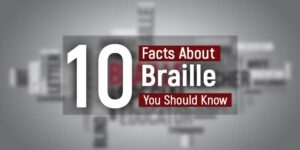Music is a universal language that transcends borders and cultures. It has the power to evoke emotions, memories, and sensations in the listener. For individuals with visual impairments, braille music is an essential means of accessing and performing music. However, transcribing music into braille is a complex and time-consuming process that poses several challenges to music braille transcription service providers.
What makes Music Braille Transcription a demanding service?
Transcribing music into braillecan be a challenging task due to the complexity of musical symbols and notations that must be represented. Unlike written language, braille music notation uses a combination of braille characters and musical symbols to convey the intricate details of music. This means that a braille music transcription must include precise representations of notes, rhythm, dynamics, and articulation.
One of the primary challenges of music braille transcription is the sheer volume of symbols and notations that must be represented. These symbols are often intricate and require precision in their placement and formatting. For example, a single braille cell can represent up to multiple different symbols, making it necessary to accurately interpret each symbol’s context to convey the intended musical expression. Even a minor error can lead to confusion and misunderstandings, which can have a significant impact on a musician’s ability to read and perform the music accurately.

In addition to the technical aspects of the transcription process, music braille transcribers must also consider the formatting and layout of the end result. They must ensure that the transcription is easy to read and navigate, with clear distinctions between different sections of the music, such as the melody and the harmony. A vocal piece, a string quartet, a piano part will all be different. This requires a great deal of care and attention to detail, as well as an understanding of the needs of braille readers and their unique requirements.
In addition to the challenge of representing a large number of musical symbols and notations, the lack of standardization in braille music notation poses another significant challenge in transcribing music into braille. While print music notation has a universally recognized standard in sheet music, braille music notation has evolved differently in different parts of the world, leading to differences in the use of symbols and formatting conventions.
Although efforts have been made to standardize braille music notation, there are still variations in the use of symbols and formatting conventions. For example, the United States uses a different system of music braille notation than the United Kingdom. Moreover, there are variations within each country, as some institutions have their own formatting conventions for braille music.
As a result, it can be difficult for braille music transcribers to accurately interpret and transcribe music from different sources and regions. Such a lack of standardization in braille music notation demands transcribers to be knowledgeable in different systems and to pay close attention to the specific conventions used in each individual source to maintain accuracy.
To Sum It Up
Overall, music braille transcription is a complex and challenging process that requires a significant amount of time, effort, and expertise. It is a testament to the skill and dedication of braille music transcribers that they are able to create accurate and comprehensive braille transcription that enable blind musicians to read and perform music with the same level of proficiency as sighted musicians.
Despite the challenges of transcribing music into braille, it is an essential task that ensures that individuals with visual impairments can access and enjoy the power of music. Braille music transcribers play a crucial role in facilitating this access, and their dedication and expertise are invaluable to the music community. At Braille Music and More, we understand the importance of accurate and timely braille transcription for individuals who rely on braille as their primary means of accessing and enjoying music. Whether it’s for personal enjoyment, education, or professional purposes, the ability to read and play music in braille can make a significant difference in the lives of visually impaired individuals. Contact us for authentic and on-time braille transcription services.







